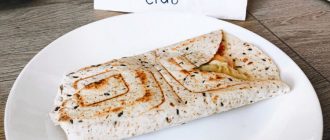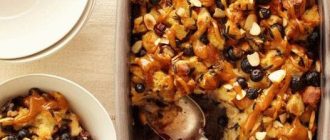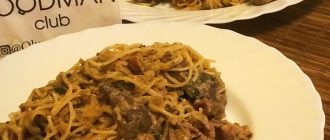All you need to make the perfect pasta dough is simple ingredients and a little love. Nutrition value per serving: (total 6) Calories 426, total fat 7.5 g, saturated fat g., proteins 17 g., Carbohydrates 71 g., Fiber g., Cholesterol mg., Sodium mg., сахар г.  AT ремя: 1 час. Complexity: easy Servings: 6 The recipes use volumetric containers with a volume of: 1 glass (st.) – 240 ml. 3/4 cup (st.) – 180 ml. 1/2 cup (Art.) – 120 ml. 1/3 cup (st.) – 80 ml. 1/4 cup (st.) – 60 ml 1 tablespoon (tbsp.) – 15 ml. 1 teaspoon (tsp) – 5 ml
AT ремя: 1 час. Complexity: easy Servings: 6 The recipes use volumetric containers with a volume of: 1 glass (st.) – 240 ml. 3/4 cup (st.) – 180 ml. 1/2 cup (Art.) – 120 ml. 1/3 cup (st.) – 80 ml. 1/4 cup (st.) – 60 ml 1 tablespoon (tbsp.) – 15 ml. 1 teaspoon (tsp) – 5 ml
Ingredients for the recipe:
- 6 large eggs
- 600 gr Italian wheat flour type “00”
Recipes with similar ingredients: fresh dough, higher flour varieties, eggs
Recipe preparation:
- Pour the flour onto a work surface. Make a deepening in the middle and break the eggs there. Beat eggs with a fork until homogeneity. With your fingertips, mix the eggs with flour, connecting little by little until everything mixes up. Connect the pieces of dough – a little effort, love and attention, and they will form one big homogeneous test com!
- You can also make dough in a food processor. Simply load the ingredients into it and mix until flour look like bread crumbs. Then put the mixture on the working surface and hands blind the dough into a lump.
- When everything is ready, knead the dough and knead hands to form gluten, otherwise the paste during cooking will be soft and loose, but not elastic (for the state of al dente). ВKneading the dough is no secret. You just need to bang with his hands, crushing to the table, shaping, kneading, stretching, and again crushing the base of the palm. That’s pretty laborious work – after a few minutes it becomes clear why Italian grandmothers hands like a boxer! You will understand when stop: the dough will be soft and silky to the touch without the roughness that flour gives.
- Now you just need to wrap it in cling film and put in refrigerator – it should rest at least half an hour before using. Check that the film covers it well, otherwise the dough will dry and crust (From this, when rolling there will be lumps of noodles, and nobody will like them!).
-
How to roll pasta
Firstly, if you do not have a special machine for pasta – nothing scary! All the housewives I met while traveling in Italy, rolled noodles with rolling pins, and did not even think to buy typewriter! In rolling, the most important thing is to achieve the fineness of the test, with which you can work with. Pretty hard to roll right away one big lump of dough, and for this you will need a very long rolling pin. Alternatively, you can roll many small pieces test instead of a few large ones. With manual rolling will be get a more rounded shape compared to long rectangles that the machine rolls. Manifest quick wits and everything will be fine!
- If using a pasta machine, it must be firmly fixed on a clean work surface (select the longest surface from available). So far, remove all unnecessary from the table – pieces paper, kettle, bread box, school notebooks and more. It will take less than a minute, and work with a clean surface will be much easier, believe me.
- Sprinkle the surface with flour like “00”, take a piece of dough the size of a large orange and fingers flatten it. Set machine rollers as wide as possible and scroll through them a piece of dough. If it sticks, lightly sprinkle it with flour. Switch the knob to the next thickest position and again scroll the dough. Fold it in half, reinstall the most wide distance between the rollers and scroll the dough again typewriter. Repeat this process five to six times. It could seem, that nothing changes, but in fact you are rolling out the dough – turning and scrolling it through the rollers several times, you will feel the difference. The dough will be smooth as silk, which means you get great pasta!
- Now you need to roll out the dough as it should, passing it through machine on all settings – from the widest position to the very narrow. Each time, skipping the dough, lightly sprinkle it with flour with both sides. When you get to the smallest distance between rollers, to obtain a neat sheet of paste sequentially fold it in half three times. Get a piece of dough resembling a square. Flip it 90 degrees and scroll to typewriter in the widest position. At the last rolling through all levels you should get a nice rectangular sheet silky pastry with smooth edges – just like the professionals! If the dough is slightly broken along the edges, fold it once in half, put the rollers wider a couple of positions and scroll again dough. This should solve the problem.
- In both manual and machine rolling, it is important to know when stay. If you cook pasta tagliatelle, lasagna or stracci, you need to roll the dough to the thickness of the playing card or coasters for beer mugs. If you are going to start pasta – for example, make ravioli or tortellini – you need to roll it a little finer, or to the extent that through it you will be clearly see your hand or printed text in a newspaper.
- Once you have rolled the paste in the desired way, you immediately need to give it shape or cut it. It dries much faster than you think so no matter what recipe you choose paste for more than 1-2 minutes before cutting. On the dough you can put a damp clean dishcloth so that it doesn’t withered up.








